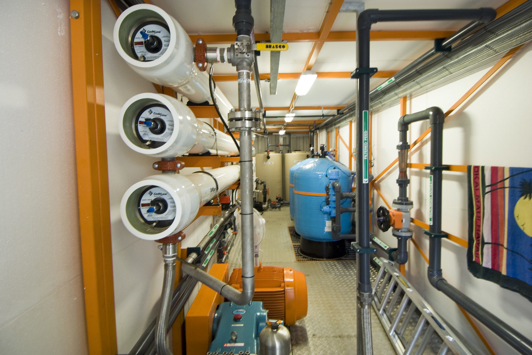How desalination works
Desalination is the process that removes much of the salt (total dissolved salts, TDS) from water sources, such as seawater, brackish water or saline groundwater.
- It produces 2 components: product water (permeate) and reject water discharge (concentrate).
- Product water has a low salt concentration, and the reject water discharge contains a high salt concentration.
- The ratio of fresh water to reject water discharge varies from 20% to 70%, depending on the technology used and the salinity of the available feed water.
Regulations on saline effluent disposal
The pumping of groundwater and disposal of saline effluent (reject water) from desalination is covered by regulations. These require landowners or occupiers to notify the Commissioner of Soil and Land Conservation before any water discharge takes place. Notification is required in writing via a standard form supplied
The department carries out the requirements of the Soil and Land Conservation Act 1945 to mitigate and prevent land degradation throughout Western Australia. This responsibility includes administering the Soil and Land Conservation Regulations 1992. These apply to any landholder who proposes the use of a reverse osmosis plant as part of salinity management.
Before buying a reverse osmosis plant
This is a large financial commitment to make. Before investing in a costly plant that produces reject water pumped as discharge, it is critical to ensure you can comply with all regulations. Part of this will require you to notify the Commissioner of Soil and Land Conservation of your intention to drain or pump water from under the land surface, and discharge that water onto other land, or into other water or a water course.
Notify the Commissioner
Before any proposed land drainage, it is a legal requirement to submit a written Notice of Intent to Drain or Pump (NOID) to the Commissioner of Soil and Land Conservation.
This must be lodged at least 90 days before draining surface or subsurface water to control salinity and discharging that water onto other land, into other water or into a watercourse, including onto the same property.
Submit this form, together with neighbour comments, before going ahead with any large machinery purposes.
Notice of intent to drain or pump – desalinationDesalination as a source of degradation
Saline groundwater is a potential water source for on-farm use, but only if the salt level can be reduced so that it is fit for purpose. Desalination plants may achieve this. But their discharge of reject water onto land, into waterbodies or existing waterways, can cause damage to the environment, and negatively affect downstream neighbours, breaching the Soil and Land Conservation Regulations 1992.
Why advance notification of intent to drain is required
A landholder (owner or occupier) planning to use a reverse osmosis plant is required to lodge a Notice of Intent to Drain (NOID) that covers any works designed to take groundwater and discharge all or part of that water onto other land, other water or into a watercourse. This applies even when the discharge is onto the same property.
The NOID must be submitted at least 90 days before the water is discharged. The 90-day assessment period allows the Commissioner to consider whether land degradation is likely to occur as a result of the saline discharge.
Failing to lodge an NOID is an offence and may lead to prosecution. The maximum penalty is $2,000 for an individual and $10,000 for a body corporate.

